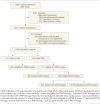Association between treated and untreated obstructive sleep apnea and risk of hypertension
- PMID: 22618924
- PMCID: PMC4657563
- DOI: 10.1001/jama.2012.3418
Association between treated and untreated obstructive sleep apnea and risk of hypertension
Abstract
Context: Systemic hypertension is prevalent among patients with obstructive sleep apnea (OSA). Short-term studies indicate that continuous positive airway pressure (CPAP) therapy reduces blood pressure in patients with hypertension and OSA.
Objective: To determine whether CPAP therapy is associated with a lower risk of incident hypertension.
Design, setting, and participants: A prospective cohort study of 1889 participants without hypertension who were referred to a sleep center in Zaragoza, Spain, for nocturnal polysomnography between January 1, 1994, and December 31, 2000. Incident hypertension was documented at annual follow-up visits up to January 1, 2011. Multivariable models adjusted for confounding factors, including change in body mass index from baseline to censored time, were used to calculate hazard ratios (HRs) of incident hypertension in participants without OSA (controls), with untreated OSA, and in those treated with CPAP therapy according to national guidelines.
Main outcome measure: Incidence of new-onset hypertension.
Results: During 21,003 person-years of follow-up (median, 12.2 years), 705 cases (37.3%) of incident hypertension were observed. The crude incidence of hypertension per 100 person-years was 2.19 (95% CI, 1.71-2.67) in controls, 3.34 (95% CI, 2.85-3.82) in patients with OSA ineligible for CPAP therapy, 5.84 (95% CI, 4.82-6.86) in patients with OSA who declined CPAP therapy, 5.12 (95% CI, 3.76-6.47) in patients with OSA nonadherent to CPAP therapy, and 3.06 (95% CI, 2.70-3.41) in patients with OSA and treated with CPAP therapy. Compared with controls, the adjusted HRs for incident hypertension were greater among patients with OSA ineligible for CPAP therapy (1.33; 95% CI, 1.01-1.75), among those who declined CPAP therapy (1.96; 95% CI, 1.44-2.66), and among those nonadherent to CPAP therapy (1.78; 95% CI, 1.23-2.58), whereas the HR was lower in patients with OSA who were treated with CPAP therapy (0.71; 95% CI, 0.53-0.94).
Conclusion: Compared with participants without OSA, the presence of OSA was associated with increased adjusted risk of incident hypertension; however, treatment with CPAP therapy was associated with a lower risk of hypertension.
Figures
Comment in
-
Filling in the pieces of the sleep apnea-hypertension puzzle.JAMA. 2012 May 23;307(20):2197-8. doi: 10.1001/jama.2012.5039. JAMA. 2012. PMID: 22618928 Free PMC article. No abstract available.
-
Analysis of recent papers in hypertension: Treatment of obstructive sleep apnea with continuous positive airway pressure appears to decrease the incidence of incident hypertension.J Clin Hypertens (Greenwich). 2013 Feb;15(2):85-7. doi: 10.1111/jch.12041. Epub 2012 Dec 14. J Clin Hypertens (Greenwich). 2013. PMID: 23339724 Free PMC article. No abstract available.
References
-
- Young T, Palta M, Dempsey J, Skatrud J, Weber S, Badr S. The occurrence of sleep-disordered breathing among middle-aged adults. N Engl J Med. 1993;328(17):1230–1235. - PubMed
-
- Marin JM, Carrizo SJ, Vicente E, Agusti AG. Long-term cardiovascular outcomes in men with obstructive sleep apnoea-hypopnoea with or without treatment with continuous positive airway pressure: an observational study. Lancet. 2005;365(9464):1046–1053. - PubMed
-
- Yaggi HK, Concato J, Kernan WN, Lichtman JH, Brass LM, Mohsenin V. Obstructive sleep apnea as a risk factor for stroke and death. N Engl J Med. 2005;353(19):2034–2041. - PubMed
Publication types
MeSH terms
Grants and funding
LinkOut - more resources
Full Text Sources
Other Literature Sources
Medical



